
The device and principle of operation of the preheater Webasto
Content
Car operation in winter is associated with many inconveniences. For example, a diesel engine may not start well in cold weather. The gasoline unit, too, depending on the weather, can be "capricious" in a similar way. In addition to the difficulties with starting and warming up the power unit (about why the engine needs to be warmed up, read in another review), the motorist may be faced with the need to heat the interior of the car, since during the overnight stay it can cool down decently.
But before the standard interior heater starts giving off heat, it may take several minutes (it depends on the ambient temperature, on the car model and on the efficiency of the cooling system). During this time, in the cold interior of the car, you can catch a cold. The reason for this slow heating operation is that the interior fan heater is powered by heating the coolant. Everyone knows that antifreeze heats up in a small circle until the engine reaches operating temperature (about what parameter it is, read here). After the thermostat is triggered, the liquid begins to circulate in a large circle. Read more about the operation of the cooling system. separately.
Until the engine reaches operating temperature, the interior of the car will be cold. To separate these two processes (powertrain heating and interior heating), car manufacturers are developing different systems. Among them is the German company Webasto, which has developed an additional cabin heater (also called a preheater).
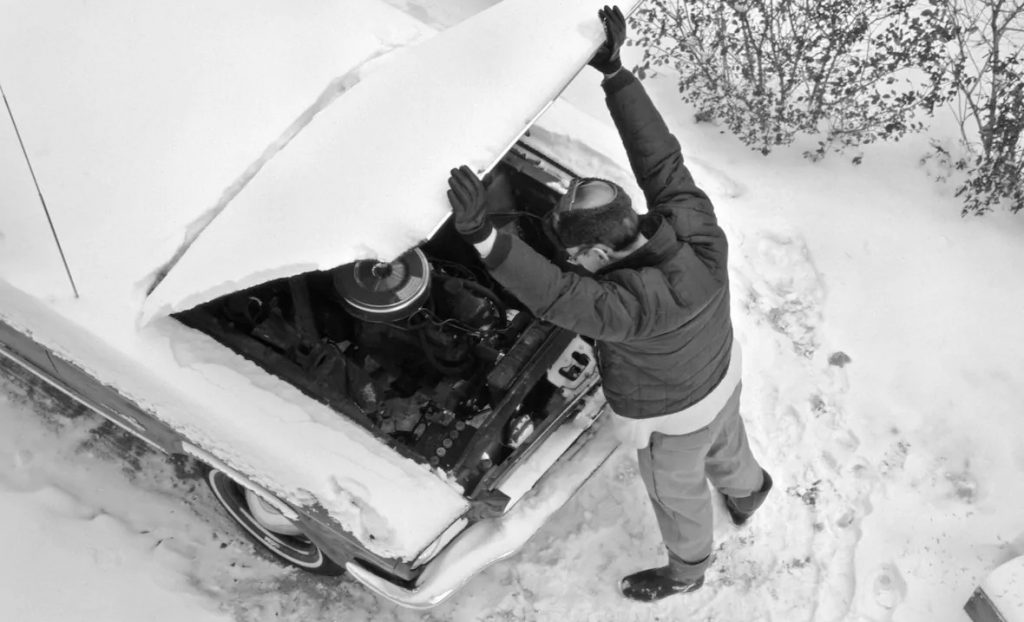
Let's consider what is the peculiarity of this development, what modifications are, as well as some tips for using the device.
What's this
For over 100 years, the German manufacturer Webasto has been manufacturing various car parts. But the main direction is the development and manufacture of various modifications of prestarting systems, air conditioning units, which are used not only in cars, but also in special equipment. They are also equipped with various heavy transport, as well as sea vessels.
In short, the Webasto pre-heater is an autonomous heater - a device that makes it easier to warm up the power unit and its subsequent easier start. Depending on the type of system, it can also heat the vehicle interior without activating the power unit. These products will be especially useful for truckers who may find themselves in a cold region, and leaving the engine running throughout the night is too expensive (in this case, fuel is consumed in a larger volume than when the Webasto system is operating).

Webasto has been developing and mass-producing all kinds of heating systems for vehicles since 1935. The brand itself was founded in 1901 by Wilhelm Bayer the Elder. The name Webasto itself comes from a combination of letters in the surname of the founder. WilHElm BAere STOckdorf. In 1965, the company began producing car air conditioners. Two years later, electric soft roof systems for cars appeared in the arsenal of products.
An additional project of the company is the development of the design of the Spirit of Ecstasy emblem, which is hiding under the hood with the help of an electric drive. This statuette is used on Rolls-Royce premium sedan models. The company also developed a chameleon roof (if necessary, becomes panoramic), which is used in the Maybach62.
Autonomous heating, engine preheating system, autonomous motor, individual interior heater - all these are some synonyms of the device in question. The device is used for the power unit in order to increase its working life (during a cold start, the internal combustion engine is exposed to serious loads, since while the lubrication system pumps the thickened oil through the channels, the engine runs without the proper amount of lubricant).
How Webasto works
Regardless of the type of device, it works according to the same principle. The only difference is in the efficiency of the heater and in the place of installation. Here is a basic diagram of how the system works.
The Control Unit is activated. This can be a remote control, a smartphone application, a timer, etc. Further, the combustion chamber is filled with fresh air (using a small electric motor or as a result of natural draft). The nozzle sprays fuel into the cavity. At the initial stage, the torch is ignited with a special candle, which creates an electrical discharge of the required power.
In the process of combustion of a mixture of air and fuel, a large amount of heat is released, due to which the heat exchanger heats up. Exhaust gases are removed to the environment through special outlets. Depending on the model of the device, the engine coolant is heated in the heat exchanger (in this case, the device will be part of the cooling system) or air (such a device can be installed directly in the passenger compartment and used only as a cabin heater).

If the model is used to heat the engine, then when a certain temperature of antifreeze (about 40 degrees) is reached, the device can activate heating in the car if the systems are synchronized. Typically, it takes about 30 minutes to warm up the motor. If the heater also activates the heating of the car, then on a frosty morning there will be no need to waste time in order to warm up the frozen windshield.
A properly installed system will last about 10 years, and during operation it will not require frequent repairs or maintenance. To prevent the system from consuming the main volume of fuel, an additional tank can be installed. This is especially practical when using high-octane fuel in the engine (read more about this parameter here).
Webasto will not work when the battery is low, so you should always keep the power source charged. For details on how to properly charge different types of batteries, read in another article... Since the heater operates with air in the passenger compartment or coolant, you should not expect that the oil in the sump will also heat up during the operation of the device. For this reason, the correct brand of engine oil should be used as described. here.
Today, there are several types of devices that differ not only in the bundle, but also have different power. If we conditionally divide them, then there will be two options:
- Liquid;
- Air.
Each option is effective in its own way. Let's consider what are their differences and how they work.
Air heaters Webasto
A car equipped with an air autonomous heater receives an additional air heater in the passenger compartment. This is its main function. The device of this mechanism includes:
- The chamber in which the fuel is burned;
- Fuel pump (power source for it - battery);
- Spark plug (for details on the device and varieties of this element, which is installed in gasoline engines, read in a separate article);
- Fan heater;
- Heat exchanger;
- Injector (read about the types of devices here);
- Individual fuel tank (its availability and volume depends on the device model).
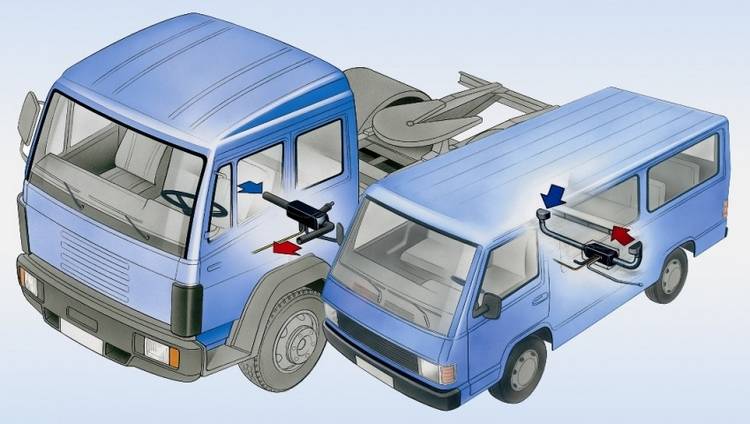
In fact, this is a mini hair dryer, only an open fire is used instead of an incandescent spiral. Such a heater works according to the following principle. The electronics starts the pump of the device. The injector starts spraying fuel. The candle creates a discharge that ignites the torch. In the process of fuel combustion, the walls of the heat exchanger are heated.
An electric impeller motor creates forced convection. Fresh air for fuel combustion is taken from outside the vehicle. But the air inside the car is used to heat the passenger compartment. The exhaust gases are removed outside the vehicle.
Since no additional mechanisms are used to operate the heater, as in the operation of an internal combustion engine, the device does not consume a lot of fuel (gasoline or diesel fuel can be used for this). For example, the design of a cabin heater does not provide for the presence of a crank mechanism (for what it is, read separately), ignition systems (about the device and types of these systems available A separate article), lubrication systems (about why it is to the motor, it is told here) etc. Due to the simplicity of the device, the pre-heating of the interior of the car works reliably and with high efficiency.
Each device model has its own power and a different type of control. For example, Webasto AirTop 2000ST operates from a conventional car battery (12 or 24V), and its power is 2 kW (this parameter affects the heating time of the passenger compartment). Such an installation can work both in a passenger car and in a truck. The control is carried out using additional electronics, which allows you to adjust the temperature regime, and is activated from the center console. The remote start of the device is performed by a timer.
Webasto liquid heaters
Liquid heater Webasto has a more complex design. Depending on the model, the weight of the block can be up to 20kg. The main device of this type is the same as that of the air counterpart. Its design also implies the presence of a fuel pump, nozzles and spark plugs for igniting gasoline or diesel fuel. The only difference is in the place of installation and the purpose of the device.
The liquid cooler is mounted in the cooling system. Additionally, the device uses an autonomous water pump, which circulates antifreeze along the circuit without using the motor. To regulate heat exchange, an additional radiator is used (for more details about the device and the purpose of this element, read in another review). The primary purpose of the mechanism is to prepare the internal combustion engine for starting (a cold engine requires more battery energy to turn the crankshaft).
The photo below shows the device of one of the types of pre-starting liquid heaters:
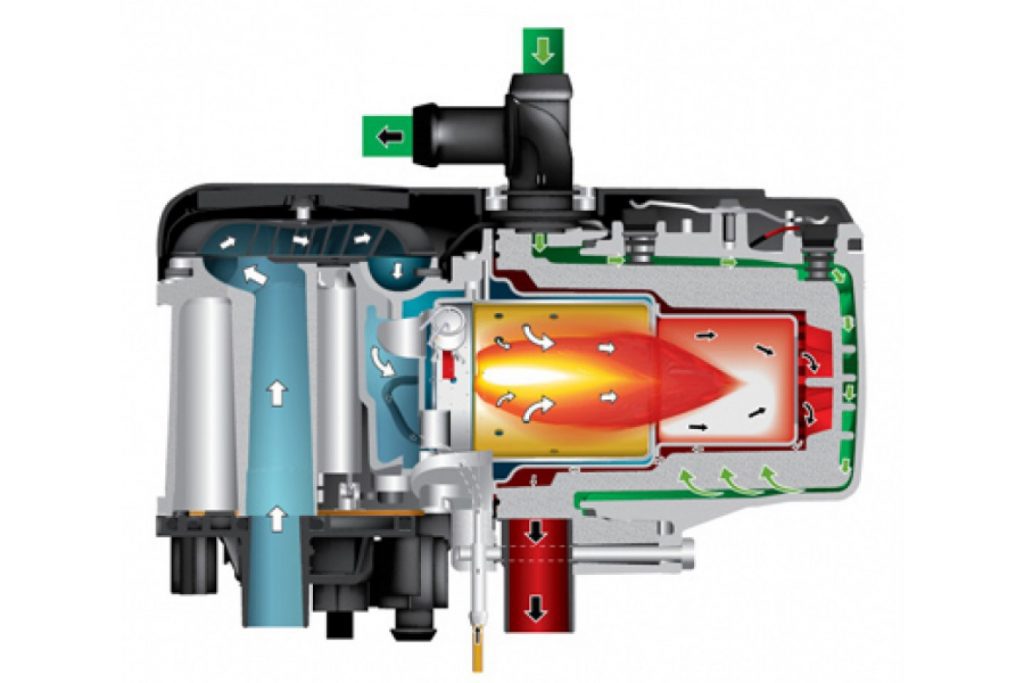
Despite the fact that this system is primarily used to preheat the engine, thanks to its operation, it is possible to warm up the interior faster. When the driver activates the ignition system and turns on the interior heater, warm air immediately begins to flow from the air deflectors. As mentioned earlier, the cabin radiator heats up due to the temperature of the antifreeze in CO. Since in a cold engine, you must first wait until the fluid in the system warms up, it can take a long time to reach the optimal temperature in the cabin (usually drivers do not wait for this, but start moving when the interior in the car is still cold, and in order not to get sick, they use heating armchairs).
Examples of models of liquid preheaters Webasto
In the arsenal of the German manufacturer Webasto there is a wide variety of preheating systems that can be used both to achieve the optimum temperature of the power unit and to activate the interior heating.
Some models are designed for only one function, but there are also universal options. Consider several types of fluid systems.
Webasto Thermo Top Evo 4
This system is installed on both gasoline and diesel engines. The installation does not consume a lot of battery power, which is not problematic for a conventional battery in good condition. For more information on how the battery works in the winter season, read in another article... The maximum power of the installation is 4 kW.
The unit is adapted to work in conjunction with engines with a volume of up to two liters, and can be included in additional configurations for cars in the middle price category. The device can work continuously for up to one hour.
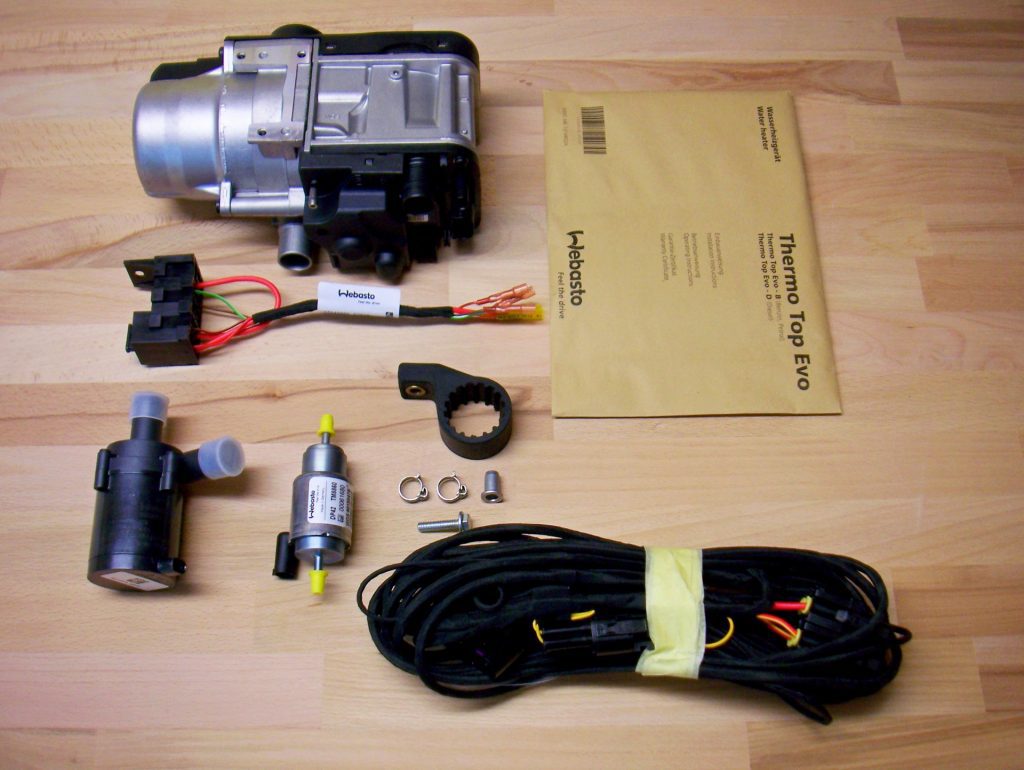
In addition to heating the power unit, this modification is also intended for heating the passenger compartment. The device is equipped with electronics that monitor the condition of the coolant. For example, when the antifreeze warms up to 60 degrees Celsius, the cabin heater is automatically activated.
To prevent the device from draining the battery and catching fire from overheating, the manufacturer has equipped the control system with appropriate protection. As soon as the temperature reaches the limit setting, the device is deactivated.
Webasto Thermo Pro 50
This modification of Webasto heaters is powered by diesel fuel. The device gives out 5.5 kW of thermal power, and consumes 32 watts. But unlike the previous model, this device is powered by a 24-volt battery. The construction weighs no more than seven kilograms. Installed in the engine compartment.
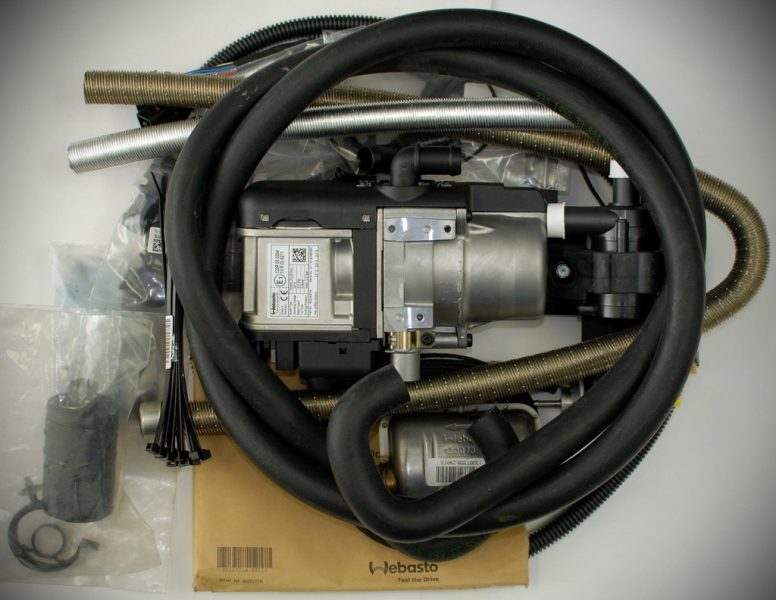
Basically, such a model is intended for heavy vehicles, which are equipped with an engine with a volume of more than 4 liters. In the settings there is a temperature setting and an activation timer. In addition to heating the power unit, the device can be integrated into the interior heating system.
WebastoThermo 350
This is one of the most powerful modifications. It is used in large buses, special vehicles, tractors, etc. The network from which the heater is powered is 24V. The block weighs almost twenty kilograms. The output of the installation is 35 kW. Such a system is effective in severe frosts. The quality of heating is at the maximum level, even if the frost outside is -40 degrees. Despite this, the device is capable of heating the working medium (antifreeze) up to +60 Celsius.
It should be noted that these are just some of the modifications. The company offers different versions of Webasto thermo, which are adapted to motors of different power and volume. The main control panel of all modifications is located on the center console (if this is non-standard equipment, then the driver himself determines where to install the control element). The list of products also includes models that are activated through the corresponding application installed in the smartphone.
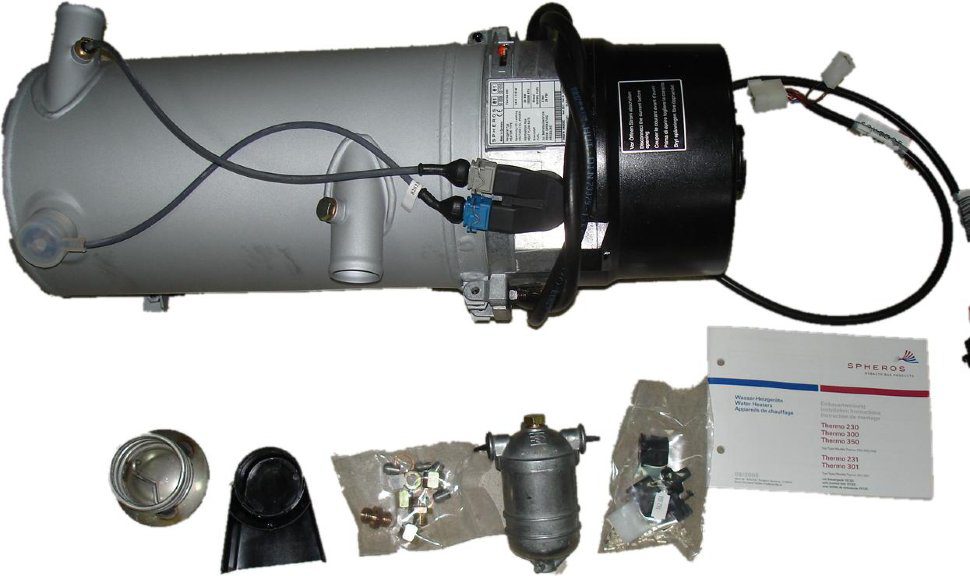
If necessary, the device can be deactivated if the driver decides that the device has reached its goal. There are also models that can be customized differently for each day of the week. Remote start of the device can be done through a small remote control. Such a key fob can have a decent range (up to one kilometer). In order for the vehicle owner to make sure that the system is activated, the remote control has a signal lamp that lights up when the signal reaches the key fob from the car.
Control options for Webasto heaters
Depending on the model of the heater, the manufacturer offers different options for controlling the operation of the system. The list of controls may include:
- Control module that is mounted on the console in the passenger compartment. It can be touch or analog. In budget versions, an on / off button and a temperature controller are used. The system is manually configured each time directly by the driver before the trip;
- A key fob operating on a GPS signal for remote starting the device, as well as setting modes (depending on the heater model, but basically the setting is done on the control panel, and the modes are activated via the key fob);
- Smartphone application "thermo call". This is a free program that not only allows you to remotely configure the required heating parameters, but can also record at what stage the interior or engine is heated at a particular moment in time. The company has developed an app for both Android and iOs users. For remote control to work, you need to purchase a SiM-card through which SMS messages will be transmitted;
- Panel with analog buttons and rotary knob that control the digital timer. Depending on the modification, the car owner can configure one or more operating modes, which will be independently activated until the electronics are turned off.
Some modifications of heaters are integrated into the immobilizer (for more details about what kind of system it is, it is described separately) or into the standard alarm system. Some people confuse this device with a remote motor start. In short, the difference is that remote activation of the internal combustion engine also allows you to prepare the car for the trip, but the vehicle starts up as usual. While the engine is warming up, the driver does not need to sit in a cold cabin.

In this case, the machine remains inaccessible to unauthorized persons. An autonomous heater does not use the resource of the power unit, and in some modifications it does not even feed from the main gas tank. Read about which is better: pre-heater or remote engine start. here.
How to manage and use Webasta
Let's consider some of the features of the operation of the autonomous interior heater and internal combustion engine heating. First of all, we recall that the device is designed for autonomous operation, and for this it must take electricity from somewhere. For this reason, the car battery must always be charged. Otherwise, the system will malfunction or not activate at all.
If a liquid modification is used that is integrated into the interior heating system, the interior heater should not be set to maximum mode. It is better to choose the middle position of the regulator, and set the fan intensity to the minimum level.
Here are the control methods, and how to use them:
- Timer start... Often, budget models are equipped with this particular control module. The user can set up a one-time activation of the system or set a specific day of the week if trips occur infrequently, and on other days there is no need to warm up the engine. The specific start time of the device and the temperature at which the system is deactivated are also configured.
- Remote start... Depending on the type of device, this remote control can spread the signal within one kilometer (if there are no obstacles between the source and the receiver). This element allows you to turn on Webasto from a distance, for example, before a trip, without leaving your home. One model of the remote control only turns on / off the system, while the other allows you to even set the desired temperature regime.
- Starting from GSM keyfob or mobile application from a smartphone... An additional SIM card is required for such devices to work. If such a function is available, then most modern motorists will definitely use it. The official application allows you to control the operation of the device through your phone. The advantage of such a control module is that it is not tied to the distance to the vehicle. The main thing is that the car is within the range of the mobile network signal. For example, a car spends the night in a guarded parking lot located far from home. While the driver walks to the car, the system prepares the vehicle for a comfortable ride. In the simplest modifications, the driver simply sends an SMS message to the Webasto card number.

Webasto will start under the conditions that:
- Outside freezing temperatures;
- The battery charge corresponds to the required parameter;
- Antifreeze is not hot;
- The car is on the alarm or all door locks are closed;
- The fuel level in the tank is not less than ¼. Otherwise, Webasto may not activate.
Let's consider some recommendations regarding the correct operation of the device.
Useful tips for use
Despite the fact that the heater, especially the air heater, has a simple design, the electronic part is quite complex. Also, some actuating elements, if used incorrectly, may fail ahead of time. For these reasons, it follows:
- Check the system performance once every three months;
- Make sure that the fuel in the gas tank or a separate tank does not thicken;
- In summer, it is better to dismantle the system so that it is not exposed to vibrations and moisture;
- The efficiency from the heater will be on daily travel in winter. If the machine is used once a week for outings in nature, then it is better not to spend money on purchasing a system;
- If it is difficult to start the heater, you need to check the battery charge, the antifreeze temperature indicator, the air inlet may be blocked.
In winter, the car's battery works worse (for how to save the car's battery in winter, read here), and with additional equipment it will discharge much faster, therefore, before the onset of winter, it is necessary to charge the power source and check the operation of the generator (how to do this is described separately).
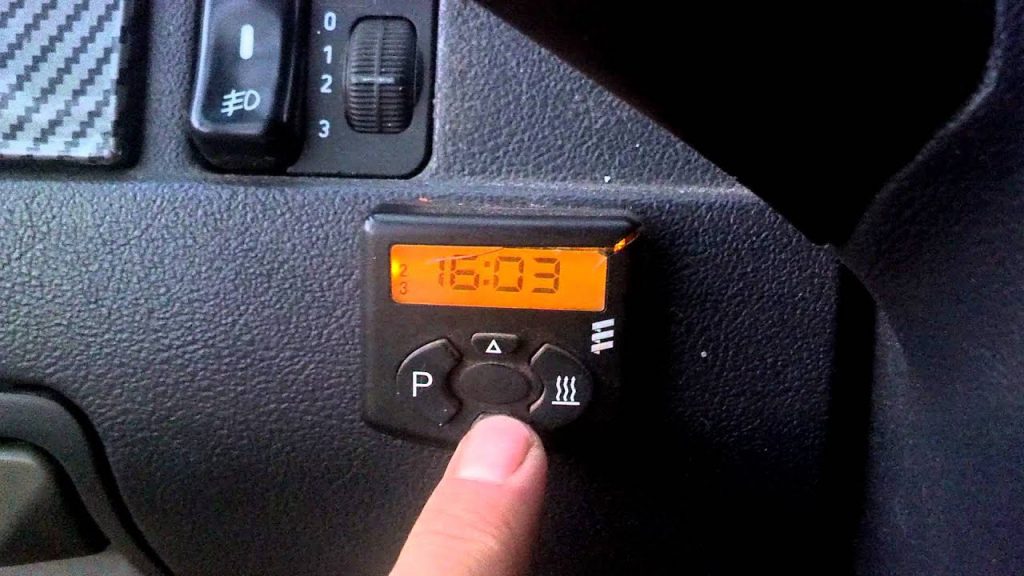
If a remote engine start system is installed in the machine and the machine is used infrequently, then there is no need to install such equipment. But the following factors should be taken into account:
- A car with a remote start of the internal combustion engine is more susceptible to theft, so many insurance companies charge an additional fee to insure such a vehicle;
- The daily start of the engine "cold" exposes the unit to an additional load, which during the winter months can be the equivalent of several thousand kilometers;
- Frequent cold start of the internal combustion engine wears out its main mechanisms more strongly (cylinder-piston group, KShM, etc.);
- The battery will drain quickly if the motor is unable to start immediately. Webasto starts independently of the engine, and does not use its resources in the process of preparing a car for a trip.
Installing the Webasto pre-heater
The air heater can be installed on any passenger car. As for the water modifications, it depends on the amount of free space under the hood and the ability to crash into a small circle of the internal combustion engine cooling system. There is a reason to install Webasta if the machine is operated daily in cold regions with frosty and long winters.
The cost of the device itself ranges from $ 500 to $ 1500. For the work, specialists will take another 200 USD. If the end justifies the means, then the installation of the equipment depends on which vehicle systems it will be synchronized with. The easiest way is to install an air modification. To do this, it is enough to choose a suitable place under the hood and bring the heater air duct into the passenger compartment. Some models are mounted directly in the passenger compartment. To prevent combustion products from accumulating in the car, it is imperative that the exhaust pipe is properly routed out.
Before starting installation work, you should evaluate your capabilities. Since this procedure can be associated with many complex manipulations with the technical part of the car, it is better to trust a specialist. Despite its simple design, the device operates by open fire, therefore it is an additional source of ignition. Incorrect connection of the elements can lead to the complete destruction of the transport, since the operation of the device is not controlled by anyone.

There are different mounting kits for each type of engine (petrol and diesel). Consider the features of installing Webasto on both types of motors.
Gasoline ICE
First, it is necessary to provide free access to the upper and lower parts of the engine cooling system. Without proper lighting, it is impossible to correctly connect the device. The device itself is installed as follows:
- Disconnect the terminals from the battery (how to do this is A separate article);
- The place is chosen where it is best to install the device. It is best to install the liquid modification as close to the internal combustion engine as possible. This will make it easier to bump into the small circle of the cooling system. In some car models, you can fix the heater on the washer container bracket;
- If the installation is carried out on the washer reservoir mount, then this reservoir must be moved to another part of the engine compartment. Installation of the heater closer to the cylinder block will allow removing the maximum efficiency from the device (heat will not be lost during the supply to the main part of the circuit);
- The heater itself must be positioned in such a way relative to the motor and other equipment so that neither this device nor the nearby mechanisms and elements are damaged during operation;
- The fuel line must be separate, so the gas tank is removed and the fuel hose is connected to it. The line can be secured next to the main fuel pipes. The pre-heater pump is also installed outside the tank. If a device with an individual tank is used, then it must be placed where it will be well ventilated and will not be exposed to strong heating in order to avoid spontaneous ignition;
- To prevent vibrations from the Webasto fuel pump from being transmitted to the body, a vibration-absorbing gasket must be used at the attachment point;
- The control module is being installed. This small panel can be positioned in any place convenient for the driver so that the device can be easily set up, but at the same time these buttons could not be confused with other control buttons located nearby;
- The wiring is connected from the battery to the control unit;
- Connecting pipes to the inlet of cold antifreeze and the outlet of hot. At this stage, you need to know exactly how the coolant circulates around the circuit. Otherwise, the heater will not be able to warm up the entire line of the small circle;
- A pipe is installed to remove the waste gas. In most cases, it is taken out into the wheel arch at the front of the car. The exhaust pipe must be connected to the main exhaust system. Experienced craftsmen recommend making a longitudinal cut of the pipe, which will facilitate the sealing of the pipe - it can be pulled together with a metal clamp (since this element has greater rigidity, it will take a lot of effort to firmly connect the parts);
- After that, a fuel hose is connected to the heater, and the device itself is fixed in place under the hood;
- The next step concerns the manipulation of the cooling system. First of all, you need to partially drain the antifreeze in order to lower its level and during installation it did not pour out;
- The branch pipes are connected to the tees (included in the kit) and are clamped with the same clamps as the main branch pipes;
- Coolant is poured;
- Since the device can operate in different modes, it has its own fuse and relay box. It is necessary to find a suitable place where to install this module so that it is not exposed to vibrations, high temperature and moisture;
- An electric line is being laid. In this case, it should be borne in mind that the wires are not on the ribbed parts of the body (due to constant vibrations, the harness may fray and contact will disappear). After installation, the wiring is connected to the vehicle's on-board system;
- We connect the battery;
- The internal combustion engine starts, and we let it run for about 10 minutes in idle mode. This is necessary in order to eliminate air plugs from the cooling system, and, if necessary, antifreeze could be added;
- The final stage is to check the performance of the pre-heating system.
At this point, the system may not turn on for several reasons. First, there may be a low fuel level in the fuel tank. In fact, this will happen even with a full gas tank. The reason is that the heater fuel line is still empty. The fuel pump takes time to pump gasoline or diesel through the hose. This can be interpreted by the electronics as a lack of fuel. Reactivating the system can correct the situation.
Secondly, after the engine warms up at the end of the installation of the device, the coolant temperature may still be sufficient for the electronics to determine that there is no need for preheating the internal combustion engine.
Diesel internal combustion engine
As for diesel engines, the mounting kits of Webasto pre-starting heaters are not much different from their counterparts designed for installation on gasoline engines. The procedure is the same, with the exception of some subtleties.
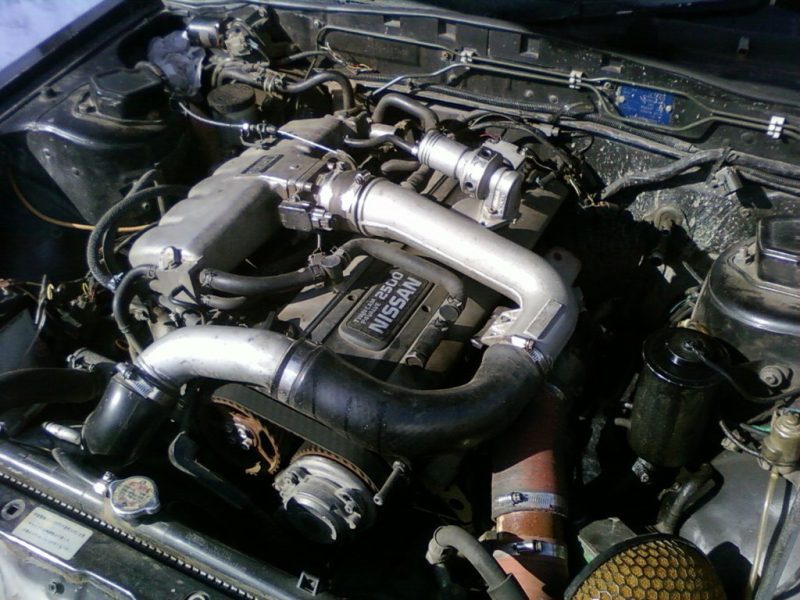
- The warm line from the heater must be fixed next to the hoses of the engine fuel system. Thanks to this, the device will simultaneously heat up the thickened diesel fuel. This approach will make it even easier to start the diesel in winter.
- The fuel line of the heater can be fed not in the gas tank itself, but from the low pressure line. To do this, you need to use the appropriate tee. There should be no more than 1200 millimeters between the feed pump of the device and the fuel tank. This is more a rule than a recommendation, as the system may not work or malfunction.
- You should not ignore the recommendations for installing Webasto, which are indicated in the manufacturer's instructions.
Advantages of Webasto pre-heaters
Since this product has been produced for more than a decade, the manufacturer has eliminated most of the shortcomings that were in the first modifications. But the equipment will be properly appreciated by those who operate their car in cold regions. For those who travel by car very rarely in winter, and frosts rarely come, the device will be of little use.
Those who often use a pre-heater note the following advantages of the device:
- German-made products are always positioned as premium quality goods, and in this case it is not just a term. Webasto heaters of any modification are reliable and stable;
- Compared to the classic heating of a car with the help of an internal combustion engine, an autonomous device saves fuel, and for the first minutes of operation, a warm power unit uses up to 40 percent less fuel;
- When a cold engine is started, it experiences heavy loads, due to which many of its parts are more worn out. The pre-heater increases the engine resource by reducing these loads - the oil in a warm internal combustion engine becomes fluid enough to be pumped through the channels of the block faster;
- Webasto buyers are offered a large selection of varieties that allow you to use all the functions of the device that are necessary for the driver;
- There is no need to wait for frozen windows to thaw before the trip;
- In the event of a breakdown of the engine or the system on which its operation depends, the driver will not freeze in frosty winter, waiting for the tow truck.
Despite these advantages, the preheater has several drawbacks. These include the high cost of the equipment itself, as well as installation work. The device works only due to the battery charge, so the power source for the "autonomous" must be efficient. Without a fuel heating system (applies to diesel engines), the heater may not work due to the inappropriate type of fuel.
In conclusion, we offer a short video comparison of the Webasto system and autorun:
Questions and answers:
How does Webasto work on diesel? The device uses fuel from the tank of the car. Fresh air enters the combustion chamber of the heater, and the fuel is ignited by a special candle. The camera body heats up, and a fan blows around it and directs hot air into the passenger compartment.
What keeps Webasto warm? Air modifications heat the interior of the car. Liquid ones heat the oil in the engine and additionally heat the passenger compartment (for this, a passenger compartment fan is used).